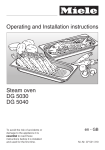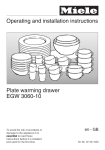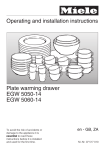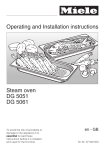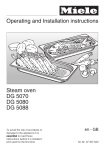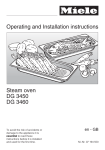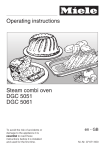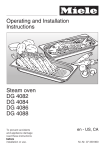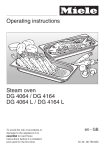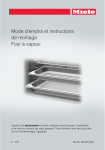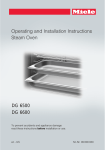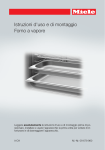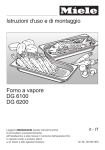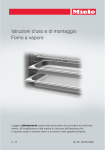Download Miele DG 1450
Transcript
Operating instructions Steam oven DG 1450 To avoid the risk of accidents or damage to the appliance it is essential to read these instructions before it is installed and used for the first time. en - GB M.-Nr. 07 831 100 Contents Warning and safety instructions . . . . . . . . . . . . . . . . . . . . . . . . . . . . . . . . . . . . . 4 Caring for the environment . . . . . . . . . . . . . . . . . . . . . . . . . . . . . . . . . . . . . . . . . . 9 Guide to the appliance . . . . . . . . . . . . . . . . . . . . . . . . . . . . . . . . . . . . . . . . . . . . 10 Front view. . . . . . . . . . . . . . . . . . . . . . . . . . . . . . . . . . . . . . . . . . . . . . . . . . . . . . . . 10 Accessories supplied . . . . . . . . . . . . . . . . . . . . . . . . . . . . . . . . . . . . . . . . . . . . . . 11 Control panel . . . . . . . . . . . . . . . . . . . . . . . . . . . . . . . . . . . . . . . . . . . . . . . . . . . . . 12 Description of the functions . . . . . . . . . . . . . . . . . . . . . . . . . . . . . . . . . . . . . . . . 13 Sensors . . . . . . . . . . . . . . . . . . . . . . . . . . . . . . . . . . . . . . . . . . . . . . . . . . . . . . . . . 13 Display . . . . . . . . . . . . . . . . . . . . . . . . . . . . . . . . . . . . . . . . . . . . . . . . . . . . . . . . . . 13 Condensate tray . . . . . . . . . . . . . . . . . . . . . . . . . . . . . . . . . . . . . . . . . . . . . . . . . . 14 Water container . . . . . . . . . . . . . . . . . . . . . . . . . . . . . . . . . . . . . . . . . . . . . . . . . . . 14 Cooking duration (time) . . . . . . . . . . . . . . . . . . . . . . . . . . . . . . . . . . . . . . . . . . . . . 14 Noises . . . . . . . . . . . . . . . . . . . . . . . . . . . . . . . . . . . . . . . . . . . . . . . . . . . . . . . . . . 14 Temperature . . . . . . . . . . . . . . . . . . . . . . . . . . . . . . . . . . . . . . . . . . . . . . . . . . . . . 15 Recommended temperature. . . . . . . . . . . . . . . . . . . . . . . . . . . . . . . . . . . . . . . 15 Heating-up phase . . . . . . . . . . . . . . . . . . . . . . . . . . . . . . . . . . . . . . . . . . . . . . . . . 16 Cooking phase. . . . . . . . . . . . . . . . . . . . . . . . . . . . . . . . . . . . . . . . . . . . . . . . . . . . 16 Before using for the first time. . . . . . . . . . . . . . . . . . . . . . . . . . . . . . . . . . . . . . . 17 Cleaning for the first time . . . . . . . . . . . . . . . . . . . . . . . . . . . . . . . . . . . . . . . . . . . . 17 Setting the correct boiling point for water . . . . . . . . . . . . . . . . . . . . . . . . . . . . . . . 18 Operation . . . . . . . . . . . . . . . . . . . . . . . . . . . . . . . . . . . . . . . . . . . . . . . . . . . . . . . 19 Preparing the appliance for use . . . . . . . . . . . . . . . . . . . . . . . . . . . . . . . . . . . . . . 19 Setting the temperature and duration . . . . . . . . . . . . . . . . . . . . . . . . . . . . . . . . . . 19 At the end of the duration . . . . . . . . . . . . . . . . . . . . . . . . . . . . . . . . . . . . . . . . . . . 20 After use. . . . . . . . . . . . . . . . . . . . . . . . . . . . . . . . . . . . . . . . . . . . . . . . . . . . . . . . . 20 During operation . . . . . . . . . . . . . . . . . . . . . . . . . . . . . . . . . . . . . . . . . . . . . . . . . . 21 Interrupting operation . . . . . . . . . . . . . . . . . . . . . . . . . . . . . . . . . . . . . . . . . . . . 21 Changing the temperature . . . . . . . . . . . . . . . . . . . . . . . . . . . . . . . . . . . . . . . . 21 Changing the duration . . . . . . . . . . . . . . . . . . . . . . . . . . . . . . . . . . . . . . . . . . . 21 Insufficient water. . . . . . . . . . . . . . . . . . . . . . . . . . . . . . . . . . . . . . . . . . . . . . . . 22 2 Contents Additional functions . . . . . . . . . . . . . . . . . . . . . . . . . . . . . . . . . . . . . . . . . . . . . . 23 Pre-heat . . . . . . . . . . . . . . . . . . . . . . . . . . . . . . . . . . . . . . . . . . . . . . . . . . . . . . . . . 23 Programming . . . . . . . . . . . . . . . . . . . . . . . . . . . . . . . . . . . . . . . . . . . . . . . . . . . . 24 Cleaning and care . . . . . . . . . . . . . . . . . . . . . . . . . . . . . . . . . . . . . . . . . . . . . . . . 26 Appliance front . . . . . . . . . . . . . . . . . . . . . . . . . . . . . . . . . . . . . . . . . . . . . . . . . . . 27 Oven interior . . . . . . . . . . . . . . . . . . . . . . . . . . . . . . . . . . . . . . . . . . . . . . . . . . . . . 28 Drip tray, rack and cooking containers . . . . . . . . . . . . . . . . . . . . . . . . . . . . . . . . . 28 Water container . . . . . . . . . . . . . . . . . . . . . . . . . . . . . . . . . . . . . . . . . . . . . . . . . . . 29 Coupling seal . . . . . . . . . . . . . . . . . . . . . . . . . . . . . . . . . . . . . . . . . . . . . . . . . . 30 Descaling . . . . . . . . . . . . . . . . . . . . . . . . . . . . . . . . . . . . . . . . . . . . . . . . . . . . . . . . 31 Problem solving guide . . . . . . . . . . . . . . . . . . . . . . . . . . . . . . . . . . . . . . . . . . . . 33 Optional accessories . . . . . . . . . . . . . . . . . . . . . . . . . . . . . . . . . . . . . . . . . . . . . . 36 Cooking containers . . . . . . . . . . . . . . . . . . . . . . . . . . . . . . . . . . . . . . . . . . . . . . . . 36 Cleaning and care products . . . . . . . . . . . . . . . . . . . . . . . . . . . . . . . . . . . . . . . . . 38 Other accessories . . . . . . . . . . . . . . . . . . . . . . . . . . . . . . . . . . . . . . . . . . . . . . . . . 39 After sales service, data plate . . . . . . . . . . . . . . . . . . . . . . . . . . . . . . . . . . . . . . 40 Technical data . . . . . . . . . . . . . . . . . . . . . . . . . . . . . . . . . . . . . . . . . . . . . . . . . . . 41 Electrical connection . . . . . . . . . . . . . . . . . . . . . . . . . . . . . . . . . . . . . . . . . . . . . . . 42 3 Warning and safety instructions Correct application This appliance conforms to current safety requirements. Inappropriate use can, however, lead to personal injury and damage to property. To avoid the risk of accidents and damage to the appliance, please read these instructions carefully before using it for the first time. They contain important information about the safety, use and maintenance of the appliance. Keep these instructions in a safe place and ensure that all users are familiar with the contents. Pass them on to any future owner of the appliance. ~ This steam oven is not designed for commercial use. It is intended for use in domestic households and in similar working and residential environments such as: – Shops – Offices and showrooms and by residents in establishments such as: – Hostels and guest houses. ~ The steam oven must only be used as a domestic appliance as specified in the operating and installation instruction and user instruction manuals. Any other usage is not supported by the manufacturer and could be dangerous. Miele cannot be held liable for damage resulting from incorrect or improper use or operation of the appliance. ~ This appliance is not intended for use by people with reduced physical, sensory or mental capabilities, or lack of experience and knowledge, unless they are supervised while using it or have been shown how to use it correctly by a person responsible for their safety. 4 Warning and safety instructions Safety with children Technical safety ~ Keep children away from the steam ~ Before installation, check the oven at all times. It is not a toy! To avoid the risk of injury do not allow them to play with it or to play with the controls. Supervise children whilst you are using it. ~ Older children may use the appliance only when its operation has been clearly explained to them and they are able to use it safely, recognising the dangers of incorrect use. ~ Make sure that children do not attempt to open the door when the appliance is in operation. To safeguard against burning, keep children well away from the appliance at all times. ~ Do not allow children to swing on the open oven door. ~ Packaging, e.g. cling film, polystyrene and plastic wrappings, must be kept out of the reach of babies and young children. Danger of suffocation. Dispose of or recycle all packaging safely as soon as possible. appliance for visible signs of damage. Do not install and use a damaged appliance. A damaged appliance may be dangerous. ~ This appliance is supplied with a cable and moulded plug ready for connection to a switched socket. If you wish to connect it to a double-pole fused spur connection unit or to an isolator switch, or if the appliance is supplied without a plug, it must be installed and connected by a suitably qualified and competent person in strict accordance with current local and national safety regulations. The manufacturer cannot be held liable for damage caused by incprrect installation or connection. Before connecting the appliance to the mains electricity supply make sure that the connection data on the data plate (voltage and connected load) correspond with the mains electricity supply, otherwise the appliance could be damaged. If in any doubt, consult a qualified electrician. ~ The electrical safety of this appliance can only be guaranteed when continuity is complete between it and an effective earthing system which complies with current local and national safety regulations. It is most important that this basic safety requirement is present and regularly tested, and where there is any doubt, the household wiring system should be inspected by a qualified electrician. The manufacturer cannot be held liable for the consequences of an inadequate earthing system (e.g. electric shock). 5 Warning and safety instructions ~ Never open the casing of the appliance. Tampering with electrical connections or components and mechanical parts is highly dangerous to the user and can cause operational faults. ~ Installation, maintenance and repairs may only be carried out by a Miele authorised person in strict accordance with current national and local safety regulations. Repairs and other work by unqualified persons could be dangerous. The manufacturer cannot be held liable for unauthorised work. Ensure that current is not supplied to the appliance until after maintenance or repair work has been carried out. ~ If the connection cable is damaged, it must be replaced by a suitably qualified electrician with a specialist connection cable of type H 05 V V-F (pvc insulated), available from the Miele Spare Parts Department. ~ Faulty components must only be replaced by genuine Miele original spare parts. The manufacturer can only guarantee the safety of the appliance when Miele replacement parts are used. 6 ~ During installation, maintenance and repair work, the appliance must be disconnected from the mains electricity supply. ~ While the appliance is under guarantee, repairs should only be undertaken by a service technician authorised by the manufacturer. Otherwise the guarantee is invalidated. ~ Do not connect the steam oven to the mains electricity supply by a multi-socket unit or an extension lead. These do not guarantee the required safety of the appliance (e.g. danger of overheating). ~ In areas which may be subject to infestation by cockroaches or other vermin, pay particular attention to keeping the appliance and its surroundings in a clean condition at all times. Any damage which may be caused by cockroaches or other vermin will not be covered by the guarantee. Warning and safety instructions Correct use ~ For added protection, it is advisable to use heat-resistant pot holders or gloves when using the appliance. Do not let them get damp or wet, as this causes heat to transfer through the material more quickly with the risk of scalding or burning yourself. ~ If the oven is still hot, steam will escape when the door is opened. Stand back away from the appliance and wait until the steam has dissipated. ~ When putting cooking containers or the condensate tray into the oven or taking them out, take care not to spill the contents. Avoid contact with hot steam, and do not touch the hot oven interior walls. Danger of burning and scalding. ~ If using plastic cooking containers, make sure that they are heat- and steam-resistant to 100 °C. Otherwise they may melt, distort or break. ~ Do not use the appliance to heat up food in sealed jars and tins. Pressure will build up inside them and they can explode causing damage to the appliance, as well as the risk of injury and scalding. ~ Always ensure that food is sufficiently cooked or reheated. Some foods may contain micro-organisms which are only destroyed by thorough cooking at a sufficiently high temperature for long enough. Therefore, when cooking or reheating food such as poultry, it is particularly important that the food is completely cooked through. If in doubt, select a longer cooking or reheating time. ~ Do not leave cooked food in the oven and do not use any cooking containers which are susceptible to corrosion as this could lead to corrosion in the appliance. ~ The appliance is designed in such a way that there will always be a little residual water left in the water container after use. If there is no residual water, there is something wrong. Call the Service Department. ~ Do not immerse the water container in water or clean it in a dishwasher. Connecting the water container into the appliance when wet could cause an electric shock. ~ For reasons of hygiene and to prevent the build-up of moisture in the appliance, the water container should be emptied after each use. ~ Take care not to tip the water container when taking it out of the appliance. Hot water can scald. ~ To avoid the risk of scratching the appliance, do not use the casing of a freestanding appliance as a resting place for items. 7 Warning and safety instructions ~ When using an electrical appliance, e.g. a hand-held food blender, near the steam oven, ensure that the cable of the electrical appliance does not come into contact with the hot appliance. The insulation on the cable could become damaged, giving rise to an electric shock hazard. ~ When the door is open be careful not to hurt yourself on edges and corners, and especially on the door catches. Danger of injury. 8 Accessories ~ Only use genuine Miele original spare parts and accessories with this appliance. If spare parts or accessories from other manufacturers are used, this will invalidate the guarantee, and Miele cannot accept liability. The manufacturer cannot be held liable for damage caused by non-compliance with these Warning and Safety instructions. Caring for the environment Disposal of the packing material Disposing of your old appliance The transport and protective packing has been selected from materials which are environmentally friendly for disposal, and should be recycled. Electrical and electronic appliances often contain materials which, if handled or disposed of incorrectly, could be potentially hazardous to human health and to the environment. They are, however, essential for the correct functioning of your appliance. Please do not therefore dispose of it with your household waste. Ensure that any plastic wrappings, bags, etc. are disposed of safely and kept out of the reach of babies and young children. Danger of suffocation. Please dispose of it at your local community waste collection / recycling centre or contact your dealer for advice. Ensure that it presents no danger to children while being stored for disposal. 9 Guide to the appliance Front view a Control panel i Steam inlet b Ventilation outlet j Drip channel in the oven c Door seal k Floor heater d Steam channel l Temperature sensor e Compartment for water container m Steam outlet f Water container (with insert) n Drip channel in the door g Contact point for water container o Door release h Side runners 10 Guide to the appliance Accessories supplied The accessories supplied with your appliance as well as a range of optional ones are available to order from Miele (see "Optional accessories"). Condensate tray To catch excess moisture, GN 1/2 325 x 265 x 40 mm (WxDxH) DGGL 1 2 perforated cooking containers, GN 1/3 gross capacity 1.5 litres / useable capacity 0.9 litres 325 x 175 x 40 mm (WxDxH) Rack For placing your own cooking containers on Silicone grease For lubricating the coupling seal on the water container 11 Guide to the appliance Control panel a For switching on and off b For setting the temperature and cooking duration c For confirming an entry d Display 12 Description of the functions Sensors Lightly touch the sensors to operate the appliance. An audible tone will sound each time a sensor is pressed. You can deactivate this, if wished (see "Programming"). s - For switching the appliance on and off - For calling up the descaling process s+? For calling up programming ? - For setting the temperature and cooking duration - For scrolling through the Programming settings ; - For setting the temperature and cooking duration - For scrolling through the Programming settings OK - For confirming the temperature and cooking duration selected - For confirming a Programming option Display During operation numbers and symbols will appear in the display: Numbers + °C = Temperature Numbers + h = Duration p (flashing) = no water or water container not present Number(s) + k = the water container requires descaling 13 Description of the functions Condensate tray When you are using perforated containers, place the condensate tray on the floor of the appliance to collect any drops of liquid and allow them to be removed easily. Water container The maximum water level is 1.2 litres, the minimum 0.75 litres. The water level markers are located inside and outside the container. On no account exceed the upper or maximum level marker. The maximum quantity of 1.2 litres of water is sufficient to run a cooking programme at 100 °C for approx. 2 hours, and the minimum quantity of 0.75 litres of water is sufficient to run a cooking programme at 100 °C for approx. 30 minutes, providing the door is not opened. If the p symbol is flashing, either the water container is not sitting correctly or there is not enough water in it. Cooking duration (time) A duration of between 1 minute (0:01) and 9 hours 59 minutes (9:59) can be set. Noises You can hear the noise of the fan when the appliance is operating. Noises similar to those of a kettle can be heard when steam is being generated. 14 Description of the functions Temperature The steam oven has a temperature range of 40 °C to 100 °C. The appliance is set at 100 °C when the oven is switched on. You can alter the temperature in 5 °C steps. Recommended temperature 100 °C: For cooking all types of food, Reheating, Menu cooking (whole meals) Bottling, Extracting juice with steam, ........ 85 °C: For cooking fish gently. 60 °C: For defrosting. 40 °C For proving yeast, Preparing yoghurt, ...... Please refer to the "User instructions" booklet supplied with your appliance for more information on temperatures. 15 Description of the functions Heating-up phase During the heating-up phase the oven compartment is heated to the set temperature. The display will show the temperature of the cooking compartment as it rises. The duration of the heating-up phase will depend on the quantity and the temperature of the food. In general the heating-up phase will last for approx. 7 minutes. The duration will be longer if you are preparing refrigerated or frozen food. Filling the water container with hot water will shorten the heating-up time. Cooking phase The cooking phase begins when the set temperature is reached. During the cooking phase the duration remaining (time left) will be shown in the display. Please refer to the "User instructions" booklet supplied with your appliance for more information and tips on how to use your steam oven. 16 Before using for the first time Please stick the extra data plate for the appliance supplied with this documentation in the space provided in the "After sales service" section of this booklet. Cleaning for the first time Remove any protective foil and adhesive labels. Open the door by pressing on the left hand side of the door release. The door will open slightly. Water container Take the water container out of the appliance and remove the insert (see "Cleaning and care / Water container"). Rinse the water container and the insert thoroughly by hand using hot water. Do not use any washing-up liquid or detergent. Do not clean the water container or the insert in a dishwasher. Do not immerse the water container in water. Accessories / Oven interior Take all accessories out of the oven. Wash them in a mild solution of washing-up liquid and hot water or in the dishwasher. The interior of the steam oven has been treated at the factory with a conditioning agent. To remove this, clean the oven interior with a mild solution of washing-up liquid and hot water and then dry thoroughly with a soft cloth. 17 Before using for the first time Setting the correct boiling point for water Water at a high altitude above sea level will not reach the boiling point for water at sea level. To adjust the appliance for the altitude in your area, fill the water container with mains tap water (see "Operation / Preparing the appliance for use") and then run the appliance at 100 °C for 15 minutes. Proceed as described in "Operation". This procedure adjusts the appliance to the altitude in your area and also flushes out the waterways. Warning! A lot of steam will be emitted from the appliance. If you move house, the appliance will need to be re-set for the new altitude if this differs from the old one by more than 300 m. To do this, descale the appliance (see "Cleaning and care / Descaling"). 18 Operation Preparing the appliance for use ^ Fill the water container with mains tap water up to at least the "min" marker. You do not need to remove the insert. Only use mains tap water. Never use distilled or mineral water or other liquids. ^ Push the water container into the appliance until it connects. If the water container is not positioned correctly, the appliance will not heat up and after a while F20 will appear in the display (see "Problem solving guide"). ^ Place the food in the oven. ^ Switch on the appliance s. Setting the temperature and duration "100 °C" will appear in the display. "°C" will start flashing. ^ If you want to cook with 100 °C, confirm the setting with "OK". If necessary, you can reduce the temperature by touching the ? sensor. Confirm with "OK". After confirming the temperature, 3 zeros will appear in display and "h" will start flashing. ^ Set the cooking duration you want by touching ; (from 0:00 upwards) or ? (from 9:59 downwards). ^ Confirm your selection by touching "OK". The appliance will start automatically after the duration has been confirmed. If you do not complete these steps within 15 minutes, the appliance will switch itself off. 19 Operation At the end of the duration At the end of the set cooking duration, an audible tone will sound, 3 zeros will appear and "h" will flash in the display. ^ Switch off the appliance. The fan will continue to run for a while after the oven has been switched off. If you want to reduce the run-on time, you can do so by removing the water container as soon as you have switched the appliance off. Steam will escape when the door is opened. Step back from the appliance and wait until the steam has dissipated. When opening the appliance, take great care that hot water which may have collected in the drip channel in the door does not overflow. Also when taking the condensate tray or cooking containers out of the oven, take care not to spill the contents. Do not come into contact with hot steam and do not touch the hot oven sides. Danger of burning and scalding. After use ^ Remove the condensate tray and empty it. ^ Remove the water container by pushing upwards slightly as you take it out of the appliance. Empty it. ^ After each use, clean and dry the whole appliance as described in "Cleaning and care". ^ Leave the door open until the cooking compartment is completely dry. The appliance is designed in such a way that there will always be a little residual water left in the water container after use. If there is no residual water, there is something wrong. Call the Service Department. 20 Operation During operation Interrupting operation Operation is interrupted as soon as the door is opened. The heating will be switched off and the cooking duration remaining stored in memory. Steam will escape when the door is opened. Step back from the appliance and wait until the steam has dissipated. When opening the appliance, take great care that hot water which may have collected in the drip channel in the door does not overflow. Also when putting the condensate tray or cooking containers into the oven or taking them out, take care not to spill the contents. Do not come into contact with hot steam and do not touch the hot oven sides. Danger of burning and scalding. Operation will resume when the door is closed. The oven will heat up again and the display will show the temperature in the cooking compartment as it rises. Once the set temperature has been reached, the display will change to show the cooking duration remaining as it counts down. Changing the temperature You can alter the temperature at any time during operation. Touch the "OK" sensor once. The display will change to the temperature setting and "°C" will flash. Set the temperature as described earlier. Changing the duration You can alter the cooking duration at any time during operation. Touch the "OK" sensor twice. The display will change to the cooking duration setting and "h" will flash. Set the cooking duration as described earlier. 21 Operation Insufficient water Insufficient water is indicated by the flashing p symbol and an audible tone. ^ Remove the water container and fill it with fresh tap water. ^ Push the water container into the appliance until it connects. ^ Close the door. Operation will continue. 22 Additional functions Pre-heat Your appliance has a pre-heating function. This heats the oven interior to approx. 40 °C. The heating-up time is then shorter as the oven interior is pre-heated and therefore the cooking process takes less time. The appliance is delivered with the pre-heating function deactivated. If you wish to use it you will need to alter the setting (see "Programming / Pre-heat"). When the pre-heat function has been activated you can still choose whether you want to use it for each programme. The water container must be filled with water for pre-heating and present in the appliance. The pre-heating process will be cancelled if the door is opened. You can start the process again by switching the appliance off and then back on again. Using pre-heat ^ Switch on the appliance. 100 will appear in the display. "°C" will start flashing. Do not confirm. After a few seconds the pre-heating process will begin and the display will show the temperature as it rises. When pre-heating is finished, 100 will appear in the display and °C will flash. ^ Place the food in the oven. ^ Set the temperature and duration as normal. Not using pre-heat ^ Place the food in the oven. ^ Switch on the appliance. 100 will appear in the display. "°C" will start flashing. ^ Confirm this or set the required temperature. ^ Set the required duration. 23 Programming The standard settings listed in the chart can be altered. Several settings can be altered in succession. Programme P1 P2 P3 Status* S0 S1 Factory default settings reinstated Demonstration mode S0 Off, the appliance will heat up S1 On, the appliance will not heat up Audible tone volume S1 Very quiet S2 Quiet S3 Medium S4 P4 P5 P6 P7 Water hardness** Temperature unit Pre-heat Keypad tones Loud Hardness setting Hardness range S1 I 1-7 °dH (0.2-1.3 mmol/l) S2 II 8-14 °dH (1.4-2.5 mmol/l) S3 III 15-21 °dH (2.7-3.8 mmol/l) S4 IV >21 °dH (above 3.8 mmol/l) S1 Unit in °C S2 Unit in °F S0 Pre-heating not active S1 Pre-heating active S0 Off S1 On * The factory setting is shown in bold. **Water hardness You can use the test strip supplied to check the water hardness level, or your local water supplier will be able to advise you on the water hardness of your area. The water hardness is shown as settings I to IV equivalent to the German scale 1 to >21 °dH (0.2 >3.8 mmol/l). 24 Programming Before you begin, ensure that the appliance is switched off. ^ Touch and hold the s sensor. ^ While the s sensor is being touched, touch the ? sensor once briefly. P1 will appear in the display. ^ Touch the ; or ? sensor until the programme you want appears highlighted in the display. ^ Confirm with "OK". ^ Touch the ; or ? sensor until the status you want appears highlighted in the display. ^ Confirm with "OK". After you have altered the setting(s) required, switch the appliance off. 25 Cleaning and care Miele offer a range of branded cleaning and conditioning products. See "Optional accessories". ,Do not use a steam cleaning appliance to clean this appliance. The steam could reach the electrical components and cause a short circuit. Switch the appliance off and allow it to cool down to a safe temperature before cleaning. It should be cleaned after each use. Make sure the appliance is completely dry before closing the door. If the appliance is not going to be used for a long period of time, e.g. whilst on holiday, it should be thoroughly cleaned beforehand to prevent the build-up of odours etc. Leave the door open afterwards. Do not use commercial cleaning agents. Only use agents designed for domestic use. Do not use cleaning agents or washing-up liquids containing aliphatic hydrocarbons as these could cause the seals to swell. 26 Cleaning and care Appliance front Remove any soiling immediately. If not, it might become impossible to remove and could cause the surface to alter or discolour. Clean the front using a damp Miele microfibre E-cloth or with a clean sponge and a solution of hot water and washing-up liquid. After cleaning dry with a soft cloth. The outer surfaces of this appliance are all susceptible to scratching. Scratches on glass surfaces could even cause a breakage. Contact with unsuitable cleaning agents can alter or discolour surfaces. To avoid damaging your appliance, do not use: – cleaning agents containing soda, alkalines, ammonia, acids or chlorides, – cleaning agents containing descaling agents, – abrasive cleaning agents, e.g. powder cleaners and cream cleaners, – solvent-based cleaning agents, – stainless steel cleaning agents, – dishwasher cleaner, – oven sprays, – glass cleaning agents, – hard, abrasive sponges and brushes, e.g. pot scourers, – eraser blocks, – sharp metal scrapers. 27 Cleaning and care Oven interior Dry the oven interior, oven interior roof, door seal, drip channel, inside of the door and the compartment for the water container after each use. Use a sponge or absorbent cloth to wipe off the condensate which has built up in the compartment. Remove grease deposits with a clean sponge and a solution of hot water and washing-up liquid. Rinse with clean water and then dry the oven interior with a soft cloth. When cleaning the back of the oven cavity, make sure that nothing gets caught behind the seals around the steam inlet and outlet. Otherwise the seals could get pushed into the back panel by mistake. After prolonged use, the floor heater can become discoloured by drops of liquid. This discolouration can be removed easily with the Miele ceramic and stainless steel hob cleaner (see "Optional accessories"). After cleaning, wipe the surface with a damp cloth to remove any cleaning agent residues. Replace the door seal with a new one if it becomes porous or brittle. Door seals can be ordered from the Miele Spare Parts Department. Drip tray, rack and cooking containers Wash and dry the condensate tray, rack and cooking containers after each use. They are all dishwasher safe. Use a little vinegar to remove any bluish discolouration on the cooking containers. You could also use the Miele ceramic and stainless steel hob cleaner (see "Optional accessories"). Rinse the containers thoroughly with clean water to remove any residual cleaning agent. 28 Cleaning and care Water container Remove, empty and dry the water container after each use. ^ Release the insert by pushing the catches on the sides in towards each other and the pull it out of the container. ^ After cleaning, dry both parts of the insert thoroughly before replacing it in the water container. When replacing the insert, guide it in at an angle a and then push it downwards b as illustrated. Do not immerse the water container in water or clean it in a dishwasher. It is important to empty the water container after each use for hygiene reasons, and also to prevent condensate building up in the appliance. Do not use scouring pads or hard brushes. 29 Cleaning and care Coupling seal If the water container becomes difficult to remove and replace or the fault message F20 appears, rub a small amount of the silicone grease supplied (see "Guide to the appliance / Accessories supplied") into the inside of the coupling seal. Do not take the seal out to lubricate it! When handling silicone grease, please observe the following safety measures: – Remove any silicone grease from your skin either by wiping it off or by washing it off. – If the grease gets into the eyes, it must be rinsed out with plenty of clean water. – If it is swallowed, seek medical advice. The coupling seal should be replaced with a new one if it becomes brittle or porous or if an unusually large amount of water collects on the floor of the water container compartment. Coupling seals can be ordered from the Miele Spare Parts Department. Only use the silicone grease supplied. On no account must margarine or oil or any other domestic grease or fat be used, as these can cause the seal to swell. 30 Cleaning and care Descaling For optimum cleaning results we recommend that you use Miele descaling tablets to descale your steam oven (see "Optional accessories"). A proprietary citric acid based descaling agent can also be used. Follow the manufacturer's instructions on the packaging. Ensure that the descaling agent does not come into contact with the metal control panel or the door handle as this could cause marks. However, should any descaling agent get onto these surfaces, wipe it away immediately. The water container will need descaling after a certain number of operating hours. The display will alert you when this needs to be done. After switching on, the descaling symbol k and the number 10 will appear in the display. The number indicates that the appliance can be used a further 10 times before it locks out. If the appliance is not descaled immediately, a 9 will appear in the display the next time the appliance is switched on, and so on. The appliance will then lock and it must be descaled before it can be used again. You can start the descaling programme manually before the appliance locks out. ^ Touch s until an audible tone sounds and "0:22 h" appears in the display and the k symbol starts flashing. ^ Fill the water container with 1 litre of descaling solution. Follow the instructions on the descaling agent packaging carefully. ^ Push the water container into the appliance until it connects. Confirm with "OK". 31 Cleaning and care Descaling will now begin. The colon will flash and the k symbol will now light up constantly in the display. It is only possible to cancel the descaling process during the first minute. After that the process cannot be cancelled. Do not switch the appliance off during the descaling process. If it is switched off before the end of the process, the whole process will have to be started from the beginning again. An audible tone will sound and the p symbol will start flashing ten minutes before the end of the descaling process. The water container needs to be filled with fresh water. ^ Remove the water container and empty it. Remove the insert. ^ Rinse the water container and the insert thoroughly. ^ Replace the insert and fill the water container with 1 litre of fresh tap water. Push the water container into the appliance until it connects. The flashing p symbol will go out and the k symbol will start flashing. ^ Touch "OK" to continue the programme. The colon will start flashing and the k symbol will now light up constantly. After descaling: An audible tone will sound when the descaling process has been completed. ^ Switch off the appliance. ^ Open the door. ^ Remove the water container and empty it. ^ Dry the appliance thoroughly. ^ Make sure the appliance is completely dry before closing the door. 32 Problem solving guide ,Installation work and repairs to electrical appliances must only be carried out by a suitably qualified and competent person in strict accordance with current local and national safety regulations (BS 7671 in the UK). Repairs and other work by unqualified persons could be dangerous. The manufacturer cannot be held liable for unauthorised work. What to do if ... ... you cannot switch the appliance on. Check whether the mains fuse has tripped. If this is not the case, then disconnect the appliance from the electricity supply for approx. 1 minute. To do this: – switch off at the wall socket and withdraw the plug, or switch off at the isolator, or – disconnect the mains fuse. Reset the trip switch in the mains fuse box, and switch the appliance back on. If it still will not switch on, contact a qualified electrician or the Miele Service Department. ... the appliance does not heat up. Check whether you set the demo-mode setting by mistake (see "Programming"). ... the fan can still be heard after the appliance has been switched off. The appliance is fitted with a fan which removes steam from the oven. The fan will continue to run for a while after the appliance has been switched off. 33 Problem solving guide ... the water container has become harder to put into the appliance and take out again. Lightly lubricate the coupling seal on the water container with silicone grease, as described in "Cleaning and care / Coupling seal". ... the heating-up phase lasts an unusually long time. Check the bottom of the water container. If a thick layer of limescale has built-up, check the water hardness level that has been set. Set the correct water hardness level for your water supply (see "Programming"), and descale the appliance as described in "Cleaning and care / Descaling". If the water hardness level was in fact set correctly or the problem occurs again, contact the Service Department. ... after moving house the appliance no longer switches from the heating-up phase to the cooking phase. Altitude affects the boiling point of water. If you move house, the appliance will need to be re-set for the new altitude if this differs from the old one by more than 300 m. To do this, descale the appliance (see "Cleaning and care / Descaling"). ... during operation an unusually large amount of steam escapes or steam escapes from parts of the steam oven where it does not usually. Check whether – the door is closed properly. – the door seal is fitted correctly. If necessary, press it in all the way round the door to make sure it is fitted evenly. – the door seal is damaged, e.g. cracks can be seen. The seal must be replaced with a new one. If this does not solve the problem, call the Miele Service Department. 34 Problem solving guide ... the p symbol appears in the display and an audible tone may sound. Check whether – the water container has been pushed right into the appliance so that it connects. – there is sufficient water in the water container. The water level must be between the two markings. ... when the appliance is switched on, the k symbol and a number between 1 and 10 or "0:22h" appear in the display and the k symbol flashes. The appliance needs to be descaled. Proceed as described in "Cleaning and care - Descaling". ... F05 or F06 appears in the display. Switch the appliance off and call the Service Department. ... F20 appears in the display. The appliance does not heat up. – First of all, check whether the water container has been pushed right into the appliance so that it connects. Then switch the appliance off and then back on again. – A fault message will appear if the temperature of the oven compartment has not risen by at least 2 °C within 5 minutes of the start of the heating up phase. This can occur if, for example, a large quantity of frozen food is being prepared. – Lightly lubricate the coupling seal on the water container with silicone grease, as described in "Cleaning and care / Water container / Coupling seal". If the appliance still will not start, switch it off and contact the Miele Service Department. ... after a period of time, the door makes a noise when it is opened and closed. Lubricate the hinges with the silicone grease supplied. 35 Optional accessories Miele offers a range of useful accessories as well as cleaning and conditioning products for your appliance. These can be ordered via the internet at www.miele-shop.com or from Miele (see back cover for contact details). Cooking containers Each stainless steel cooking container has a Gastro-Norm (GN) size (Example GN 1/3). 1/3 or 1/2 indicates the width and depth of the cooking containers. DGGL 1 Perforated cooking container, GN 1/3 (supplied) Gross capacity 1.5 litres / Usable capacity 0.9 litres 325 x 175 x 40 mm (WxDxH) DGG 2 Solid cooking container, GN 1/3 Gross capacity 2.5 litres / Usable capacity 2.0 litres 325 x 175 x 65 mm (WxDxH) DGG 3 Solid cooking container, GN 1/2 Gross capacity 4.0 litres / Usable capacity 3.1 litres 325 x 265 x 65 mm (WxDxH) DGGL 4 Perforated cooking container, GN 1/2 Gross capacity 4.0 litres / Usable capacity 3.1 litres 325 x 265 x 65 mm (WxDxH) 36 Optional accessories DGGL 5 Perforated cooking container, GN 1/3 Gross capacity 2.5 litres / Usable capacity 2.0 litres 325 x 175 x 65 mm (WxDxH) DGGL 6 Perforated cooking container, GN 1/3 Gross capacity 4.0 litres / Usable capacity 2.8 litres 325 x 175 x 100 mm (WxDxH) DGG 7 Solid cooking container, GN 1/3 Gross capacity 4.0 litres / Usable capacity 2.8 litres 325 x 175 x 100 mm (WxDxH) DGGL 8 Perforated cooking container, GN 1/2 Gross capacity 2.0 litres / Usable capacity 1.7 litres 325 x 265 x 40 mm (WxDxH) Condensate tray To catch excess moisture, GN 1/2 325 x 265 x 40 mm (WxDxH) DGD 1/3 Lid for GN 1/3 cooking containers 37 Optional accessories DGD 1/2 Lid for GN 1/2 cooking containers Cleaning and care products Miele branded cleaning and conditioning products are available for your appliance. Miele descaling tablets 6 tablets For descaling the water container. Ceramic and stainless steel hob cleaner 250 ml Removes discolouration from the floor heater caused by drops of liquid. Removes discolouration from cooking containers. E-Cloth (microfibre cloth) Removes finger marks and light soiling. 38 Optional accessories Silicone grease For lubricating the coupling seal. Please read the relevant instructions in "Cleaning and care". Other accessories Multi-purpose casserole dish KMB 5000-S Die-cast aluminium casserole dish with anti-stick surface and stainless steel lid. Also suitable for use on induction hobs and in all Miele ovens. Not suitable for use on gas hobs. Maximum capacity: 2.5 kg Dimensions: 325 x 260 x 65 mm (WxDxH) 39 After sales service, data plate In the event of any faults which you cannot remedy yourself, or if the appliance is under guarantee, please contact: – Your Miele dealer, or – the Miele Customer Contact Centre (see back cover for address). Please note that telephone calls may be monitored and recorded to improve our service. When contacting Miele, please quote the model and serial number of your appliance, which are given on the data plate. N.B. A call-out charge will be applied for service visits where the problem could have been resolved as described in these instructions. Space in which to stick the extra data plate supplied with the appliance. Ensure that the model number is the same as the one on the front of these instructions. 40 Technical data This appliance is supplied with a mains cable and moulded plug ready for connection to an a.c. single phase 230 V 50 Hz supply. Connected load: 2.2 kW Dimensions (H x W x D): - Appliance see illustration - Cooking compartment 24.0 x 33.5 x 27.5 cm Weight: 19.3 kg a Inlet for mains connection cable to the appliance 41 Technical data Electrical connection All electrical work should be carried out by a suitably qualified and competent person, in strict accordance with current local and national safety regulations (BS 7671 in the UK). Installation, repairs and other work by unqualified persons could be dangerous. The manufacturer cannot be held liable for unauthorised work. Ensure power is not supplied to the appliance until after installation work has been carried out. Do not connect the appliance to the mains electricity supply via an extension lead. These do not guarantee the required safety of the appliance. Please ensure that the connection data quoted on the data plate match the household mains supply. This appliance is supplied with a cable and moulded plug for connection to a single phase 230-240 V 50 Hz supply via a suitable switched socket which should be easily accessible after installation. It can, if necessary, be connected to a suitable isolator or a double pole fused spur connection unit which complies with national and local safety regulations by a suitably qualified electrician. If the switch is not accessible after installation (depending on country) an additional means of disconnection must be provided for all poles. For extra safety it is advisable to install a suitable residual current device. When switched off there must be an all-pole contact gap of 3 mm in the isolator switch (including switch, fuses and relays). 42 Technical data Important U.K. The wires in the mains lead are coloured in accordance with the following code: Green/yellow = earth Blue = neutral Brown = live WARNING: THIS APPLIANCE MUST BE EARTHED Non-rewireable plugs BS 1363 The fuse cover must be refitted when changing the fuse, and if the fuse cover is lost, the plug must not be used until a suitable replacement is obtained. The colour of the correct replacement cover is that of the coloured insert in the base of the plug, or the colour that is embossed in words on the base of the plug (as applicable to the design of plug fitted). Replacement fuses should be ASTA approved to BS 1362 and have the correct rating. Replacement fuses and fuse covers may be purchased from your local electrical supplier. Important The electrical safety of this appliance can only be guaranteed when continuity is complete between the appliance and an effective earthing system, which complies with local and national regulations. It is most important that this basic safety requirement is tested regularly and where there is any doubt the household wiring should be inspected by a qualified electrician. The manufacturer cannot be held liable for the consequences of an inadequate earthing system such as electric shock. The manufacturer cannot be held liable for damage caused by incorrect installation or connection. 43 Alteration rights reserved / 2910 M.-Nr. 07 831 100 / 01












































